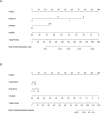Nomogram models to predict low fertilisation rate and total fertilisation failure in patients undergoing conventional IVF cycles
- PMID: 36428025
- PMCID: PMC9703318
- DOI: 10.1136/bmjopen-2022-067838
Nomogram models to predict low fertilisation rate and total fertilisation failure in patients undergoing conventional IVF cycles
Abstract
Objectives: To establish visualised prediction models of low fertilisation rate (LFR) and total fertilisation failure (TFF) for patients in conventional in vitro fertilisation (IVF) cycles.
Design: A retrospective cohort study.
Setting: Data from August 2017 to August 2021 were collected from the electronic records of a large obstetrics and gynaecology hospital in Sichuan, China.
Participants: A total of 11 598 eligible patients who underwent the first IVF cycles were included. All patients were randomly divided into the training group (n=8129) and the validation group (n=3469) in a 7:3 ratio.
Primary outcome measure: The incidence of LFR and TFF.
Results: Logistic regressions showed that ovarian stimulation protocol, primary infertility and initial progressive sperm motility were the independent predictors of LFR, while serum luteinising hormone and P levels before human chorionic gonadotropin injection and number of oocytes retrieved were the critical predictors of TFF. And these indicators were incorporated into the nomogram models. According to the area under the curve values, the predictive ability for LFR and TFF were 0.640 and 0.899 in the training set and 0.661 and 0.876 in the validation set, respectively. The calibration curves also showed good concordance between the actual and predicted probabilities both in the training and validation group.
Conclusion: The novel nomogram models provided effective methods for clinicians to predict LFR and TFF in traditional IVF cycles.
Keywords: epidemiology; reproductive medicine; subfertility.
© Author(s) (or their employer(s)) 2022. Re-use permitted under CC BY-NC. No commercial re-use. See rights and permissions. Published by BMJ.
Conflict of interest statement
Competing interests: None declared.
Figures




Similar articles
-
Multivariate analyses on male factors and construction of a nomogram for predicting low in vitro fertilization rate.Heliyon. 2024 Apr 6;10(7):e29271. doi: 10.1016/j.heliyon.2024.e29271. eCollection 2024 Apr 15. Heliyon. 2024. PMID: 38623219 Free PMC article.
-
A Bayesian network model for prediction of low or failed fertilization in assisted reproductive technology based on a large clinical real-world data.Reprod Biol Endocrinol. 2023 Jan 26;21(1):8. doi: 10.1186/s12958-023-01065-x. Reprod Biol Endocrinol. 2023. PMID: 36703171 Free PMC article.
-
Predictive value of the sperm DNA fragmentation index for low or failed IVF fertilization in men with mild-to-moderate asthenozoospermia.J Gynecol Obstet Hum Reprod. 2021 Jun;50(6):101868. doi: 10.1016/j.jogoh.2020.101868. Epub 2020 Jul 11. J Gynecol Obstet Hum Reprod. 2021. PMID: 32663655
-
Development and validation of a conventional in vitro total fertilization failure prediction model.J Assist Reprod Genet. 2023 Aug;40(8):1915-1923. doi: 10.1007/s10815-023-02851-7. Epub 2023 Jun 29. J Assist Reprod Genet. 2023. PMID: 37382786 Free PMC article.
-
Monitoring of stimulated cycles in assisted reproduction (IVF and ICSI).Cochrane Database Syst Rev. 2021 Apr 12;4(4):CD005289. doi: 10.1002/14651858.CD005289.pub4. Cochrane Database Syst Rev. 2021. PMID: 33844275 Free PMC article.
Cited by
-
Indications affect neonatal outcomes following early rescue ICSI: a retrospective study.J Assist Reprod Genet. 2024 Mar;41(3):661-672. doi: 10.1007/s10815-024-03040-w. Epub 2024 Feb 22. J Assist Reprod Genet. 2024. PMID: 38386117 Free PMC article.
-
Multivariate analyses on male factors and construction of a nomogram for predicting low in vitro fertilization rate.Heliyon. 2024 Apr 6;10(7):e29271. doi: 10.1016/j.heliyon.2024.e29271. eCollection 2024 Apr 15. Heliyon. 2024. PMID: 38623219 Free PMC article.
-
Development of a single-center predictive model for conventional in vitro fertilization outcomes excluding total fertilization failure: implications for protocol selection.J Ovarian Res. 2025 Jul 2;18(1):138. doi: 10.1186/s13048-025-01728-w. J Ovarian Res. 2025. PMID: 40605088 Free PMC article.
References
-
- Liu J, Nagy Z, Joris H, et al. . Analysis of 76 total fertilization failure cycles out of 2732 intracytoplasmic sperm injection cycles. Hum Reprod 1995;10:2630–6. - PubMed
Publication types
MeSH terms
LinkOut - more resources
Full Text Sources
